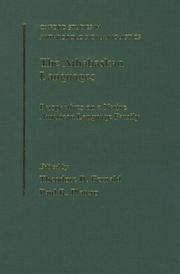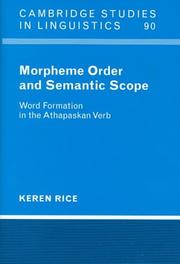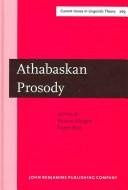| Listing 1 - 5 of 5 |
Sort by
|

ISBN: 1280761687 0195353226 9780195353228 0195119479 9781280761683 0197721281 Year: 2000 Publisher: Oxford New York Oxford University Press
Abstract | Keywords | Export | Availability | Bookmark
 Loading...
Loading...Choose an application
- Reference Manager
- EndNote
- RefWorks (Direct export to RefWorks)
The Athabaskan language family, which constitutes the largest group of Amerindian languages, poses linguistic challenges. This is a collection of articles on syntax, semantics and morphology as well as a look at the languages' struggle to survive.
Athapascan languages --- Navajo language --- Dine language --- Navaho language --- Navajú language --- Athabascan languages --- Na-Dene languages --- Tinne languages --- North and Central American indian languages --- Athapascan languages.

ISBN: 0521583543 0521024501 051166365X 0511823592 Year: 2000 Publisher: Cambridge Cambridge University Press
Abstract | Keywords | Export | Availability | Bookmark
 Loading...
Loading...Choose an application
- Reference Manager
- EndNote
- RefWorks (Direct export to RefWorks)
Athapaskan languages are well known for their intricate morphology, in particular the complexity of their verbs. The significance of these languages for linguistic theory is widely acknowledged. In this book, Keren Rice offers a rich typological survey of morpheme ordering in Athapaskan verbs, with implications for both synchronic grammar and language change. She shows that verb structure is in fact widely predictable across Athapaskan languages if appropriate syntactic factors and an overarching principle of semantic scope are taken into account. The presentation also includes a detailed study of argument and aspectual systems. This landmark volume was the first major comparative study of its type for the Athapaskan language family, combining descriptive depth with a contemporary theoretical perspective. Clear and insightful, it will interest Athapaskanists, typologists, historical and theoretical linguists alike.
Lexicology. Semantics --- Grammar --- North and Central American indian languages --- Arts and Humanities --- Language & Linguistics --- Athapascan languages --- Verb phrase. --- Word order. --- Morphemics. --- Athabascan languages --- Na-Dene languages --- Tinne languages

ISBN: 9027247838 1283092379 9027285292 9786613092373 9789027285294 9789027247834 6613092371 9781283092371 Year: 2005 Volume: 269. Publisher: Amsterdam Philadelphia J. Benjamins Pub.
Abstract | Keywords | Export | Availability | Bookmark
 Loading...
Loading...Choose an application
- Reference Manager
- EndNote
- RefWorks (Direct export to RefWorks)
This collection of articles on stress and tone in various Athabaskan languages will interest theoretical linguists and historically oriented linguists alike. The volume brings to light new data on the phonetics and/or phonology of prosody (stress, tone, intonation) in various Athabaskan languages, Chiricahua Apache, Dene Soun'liné, Jicarilla Apache, Sekani, Slave, Tahltan, Tanacross, Western Apache, and Witsuwit'en. As well, some contributions describe how prosody is to be reconstructed for Proto-Athabaskan, and how it evolved in some of the daughter languages.
Athapascan Indians --- Athapascan Languages --- Languages --- Athapascan languages --- Langues athapascan --- Athapascan (Indiens) --- Congresses. --- Congrès --- Langues --- Athabascan Indians --- Athabaskan Indians --- Athapaskan Indians --- Indians of North America --- Athabascan languages --- Na-Dene languages --- Tinne languages
Book
ISBN: 9789004436824 9789004436817 9004436820 Year: 2022 Publisher: Leiden Boston
Abstract | Keywords | Export | Availability | Bookmark
 Loading...
Loading...Choose an application
- Reference Manager
- EndNote
- RefWorks (Direct export to RefWorks)
This volume presents the up-to-date results of investigations into the Asian origins of the only two language families of North America that are widely acknowledged as having likely genetic links in northern Asia. It brings together all that has been proposed to date under the respective rubrics of the Uralo-Siberian (Eskimo-Yukaghir-Uralic) hypothesis and the Dene-Yeniseian hypothesis. The evolution of the two parallel research strategies for fleshing out these linguistic links between North America and Asia are compared and contrasted. Although focusing on stringently controlled linguistic reconstructions, the volume draws upon archaeological and human genetic data where relevant.
Aleut language --- Eskimo languages --- Eskimo-Aleut languages --- Na-Dene languages --- Uralic languages --- Yeniseian languages --- Yukaghir language --- Grammar, Comparative --- Uralic --- Yukaghir --- Yeniseian --- Eskimo-Aleut --- Na-Dene --- Uralic. --- Yukaghir. --- Yeniseian. --- Eskimo-Aleut. --- Na-Dene.
Book
ISBN: 9789027246073 9027246076 9789027286833 9027286833 1283093138 9786613093134 9781283093132 Year: 2011 Publisher: Amsterdam ; Philadelphia : John Benjamins,
Abstract | Keywords | Export | Availability | Bookmark
 Loading...
Loading...Choose an application
- Reference Manager
- EndNote
- RefWorks (Direct export to RefWorks)
This ambitious and ground-breaking book examines the linguistic studies produced by missionaries based on the Pacific Northwest Coast of North America (and particularly Haida Gwaii) during the late nineteenth and early twentieth centuries. Making extensive use of unpublished archival materials, the author demonstrates that the missionaries were responsible for introducing many innovative and insightful grammatical analyses. Rather than merely adopting Graeco-Roman models, they drew extensively upon studies of non-European languages, and a careful exploration of their scripture translations reveal the origins of the Haida sociolect that emerged as a result of the missionary activity. The complex interactions between the missionaries and anthropologists are also discussed, and it is shown that the former sometimes anticipated linguistic analyses that are now incorrectly attributed to the latter.
Haida language --- Indians --- Indians of North America --- Haida (Langue) --- Langues indiennes d'Amérique --- Indiens d'Amérique --- Discourse analysis --- Languages --- History --- Missions --- Analyse du discours --- Histoire --- LANGUAGE ARTS & DISCIPLINES --- Linguistics / General --- Haida Indians --- Languages & Literatures --- Native American & Hyperborean Languages --- American aborigines --- American Indians --- First Nations (North America) --- Indians of the United States --- Indigenous peoples --- Native Americans --- North American Indians --- Aborigines, American --- Amerindians --- Amerinds --- Pre-Columbian Indians --- Precolumbian Indians --- Ethnology --- Skittagetan Indians --- Skittagetan language --- Na-Dene languages --- Discourse analysis. --- Languages. --- History. --- Culture --- Civilization --- Langues indiennes d'Amérique --- Indiens d'Amérique --- Languages&delete& --- Linguistics --- History of Linguistics --- Missionary Linguistics --- Anthropology
| Listing 1 - 5 of 5 |
Sort by
|

 Search
Search Feedback
Feedback About UniCat
About UniCat  Help
Help News
News